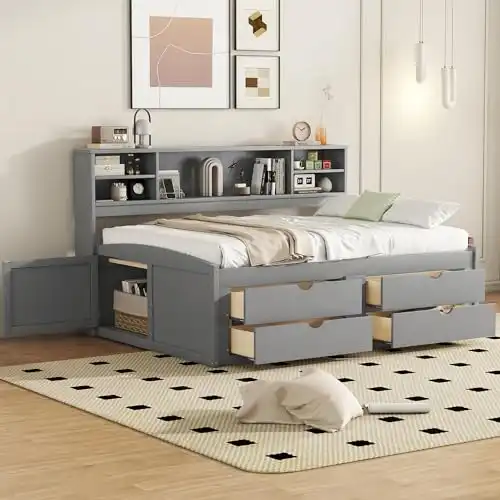One of the most important elements of a home’s livability is how it allows you to store your possessions. Your clothes and food have to go somewhere, and you might want some space for random items like your high school yearbook and gift wrapping paper too!
For many people, thinking about shipping container home storage creates a scarcity mindset: your brain immediately goes to what things you will have to give up so you can fit in a limited space. And while this does imply that you’ll have a tiny container house, that’s not necessarily true depending on your design.
Still, many people do look toward containers as a way to get a small, more efficient way of living. And with that comes reduced overall space.
There’s no way to magically create more volume than what you start off with, but you can choose to utilize the space you do have more effectively. With some innovative thinking that we’ll discuss in this article, you’ll find that you have much more tiny home storage space than you initially thought!
Using All of Your Walls for Storage
When it comes to untapped storage assets, a good place to focus your attention first is on your walls. Walls primarily serve to separate rooms from each other (or indoors from outdoors), but they actually provide some additional utility.
Think about it this way: walls bound a space, and in doing so, create areas that you can’t move through like you would if your home was one giant room. So if you can’t use the areas with walls for moving around, you might as well use them to hold things!
Even when a wall is already partially utilized for storage, think about how you could possibly make use of the space above or below what’s already there. The area all the way from the floor to the ceiling is at your disposal, after all.
Yes, everyday items should be located roughly at waist-to-head height (in the neighborhood of 3 ft to 6 ft off of the floor). But spaces that are very high or very low are still great places for infrequently used items.
Wall Shelves
The obvious place to start with wall utilization is shelves. And whether you go with freestanding shelves, wall-mounted shelves, or ceiling-hung shelves, the benefits are largely the same.
Shelves give you the ability to hold boxes, tins, and other containers. Or just objects that due to size and shape don’t lend themselves to hanging individually.
The problem with shelves is that if you make them too deep, you lose track of things in the back! This is especially true for shelves that are very high or very low. All of us have probably found ourselves standing on a chair or still, digging through items hidden on the back row of a shelf.
Nevertheless, shelves are a foundational element of your container storage plan. You can certainly purchase pre-made shelves, or build custom shelves of your own.
A middle-ground would be buying an adjustable shelving kit made for pantries and closets with vertical tracks that enable you to reconfigure the position of shelves over time.
Remember that even if a particular wall feels too narrow to use for a conventional shelf, a corner-shelf is a great option worth exploring to get an extra bit of storage.
Wall Storage for Hanging Items
Hanging certain commonly used items directly from the wall is a good choice. A wall-hung tool can be accessed quickly without searching and this storage mechanism enables you to quickly and visually determine if something is missing. It also saves you table and counter space for the other things you have that can’t be hung as easily.

What can be hung from a wall? More things than you think. Examples include coats, knives, kitchen utensils, keys, brooms, blankets, and more.
You also have a number of options on how to hang items. The most obvious choice is screwing a bracket or hook into the wall. You could also use adhesive hooks, some of which are fairly strong and yet also removable. Attaching via epoxy is extremely strong and permanent and doesn’t require any drilling or mechanical fasteners.
In the above section, we mentioned adjustable shelving kits, and there are similar options for hanging items. Pegboard, slatwall, and track systems all permit numerous configurations of hooks and other attachments. And they can actually help continue the modern, industrial look many container homeowners are looking for.

One other option to explore if you have a section of exposed shipping container wall in your home is magnets. Industrial-strength rare-earth magnets commonly made from Neodymium can hold a surprising amount of weight. However, don’t be confused about their stated weight rating as they will slide down a wall with much less force than what is required to actually remove them.
If you have an exposed container steel wall but don’t want to use magnets. you still have options like welding, bolting, or epoxying on attachment points.
Above-the-Door Storage
Another often-overlooked section of wall space is the small sliver above doorways (and similar areas like windows and mirrors as well). While many people will write these sections off as too small to be worth the trouble, a simple shelf like the one below is quite simple to add.
Depending on the height of your ceiling (which is driven by the type of containers you use), you may have enough vertical space for several boxes or tubs.
Under-Bed Storage
Beds take up a lot of space, especially in a tiny home. For instance, a Queen-sized bed uses a little over 33 square feet of floor area. But, what if the space the bed occupies could serve another purpose at the same time?
Most people don’t want to lay on a mattress that’s on the floor. It makes it hard to get up and down, hard to see out of windows, etc. Instead, most prefer their bed to be a few feet off of the floor. As a secondary benefit, having the bed slightly elevated opens up the area underneath as a potential storage location.
Open Storage
A typical bed frame gives between six inches and a foot of clear space under the bed. You may have one in your house right now, and if so, your pet is probably resting under it!

These open storage spaces require a large bed skirt to hide what you’re storing, and they are still easily accessible by pets and small children due to a lack of cabinetry around them. They also make it a bit more difficult to access your stored goods that aren’t near the edge of the bed frame. However, special boxes and totes with a short height that slide under beds can be found, like the ones below.
Beds with Drawers
Another option is to purchase a bed that is designed with drawers as part of the bedframe. This is significantly more expensive than a simple metal bed frame, but it does give you access to a lot of secure storage underneath and a professional look.
You’re unlikely to find one of these beds that is more than a foot or two high, so you’ll be capped out on storage space. And if you have any oddly shaped items, they may not always fit in the available drawers.

These types of beds are sometimes called Captain’s Beds, named after the bed that the captain of a ship might have in his private quarters to hold his personal items. They can also be considered a type of platform bed, although that general category doesn’t necessarily include storage areas and just indicates that the bed is elevated on a platform.
The Captain’s Bed above is an example of one that is meant to be placed sideways against a wall. This can actually be a great option for a tiny container home with narrow rooms if you don’t mind only being able to enter the bed from one side.
Tilt-Up Bed
Taking a page out of the RV industry’s playbook leads us to tilt-up beds. With one of these beds, you hinge the support slats or plywood under the mattress, allowing it to be raised up on one end. This provides access to a cavernous, enclosed space beneath the bed.

Thanks to lift-supporting gas struts similar to the ones you’ll see on the hood and trunk of your car, the bed takes minimal effort to open and will stay open until pulled down. You can purchase an affordable kit like the one below to make your own tilt-up bed that integrates perfectly into your container home design.
Because tilt-up beds are often sold as kits, you can make the bed as high as you want. In other words, you can make the storage area below the bed as deep as you want to create as big of a storage space as you need. Just make sure that when the bed tilts up, it doesn’t hit the ceiling or light fixtures!
Lofted Bed
If you want to get even more storage, you can move the bed higher and create a lofted bed. Essentially the top half of a set of bunk beds, a loft allow enough space for a couch, a desk, or even storage in the form of a wardrobe.
Depending on how high you go with your loft, you may even be able to stand underneath it! And yet, a lofted bed is still a piece of furniture that can be moved around the room or house.
Other Storage Quick Wins from Unutilized Household Dead Space
Think about the full volumetric space that an object occupies. How much of that space is dedicated to the function of the object and how much is just wasted? It’s the same idea as what we just discussed with beds.
Hidden Storage in Chairs
For instance, a typical chair is just an elevated surface to keep people from sitting on the floor. While a chair’s seating surface is typically a foot or two off the ground, the area below the seat is open. Why not use that space?
You can purchase or make chairs with drawers underneath, chairs with storage bins under the cushions, and even unique folding chairs that don’t take up any space at all when not in use.

Don’t be afraid to stretch the definition of what constitutes a chair, as there are plenty of fun storage ottomans as well that you can easily sit on.
Finding Storage with Tables and Desks
Tables and desks are similar to chairs in that they have tons of wasted space below the primary functional surface. This ‘dead space’ underneath a table or desk is just a function of having a horizontal surface suspended above floor level. Yes, in some cases you may have to make allowances for a space to place your legs, but you can work around this requirement with creative designs.
For instance, a tabletop can fold out of a wall or other piece of furniture and provide leg space underneath when needed. Or you can find a table and chairs that perfectly fit together when not in use.

Using Steps as Storage
Staircases also make excellent storage areas. Whether you actually build a multi-story container home, have a lofted bed, or a slightly raised room, you can use the space underneath to hold tons of items.

The front face of a step works great as a drawer face. or you can have cabinets on the side of steps depending on your design and access considerations.

Some people forgo building a proper staircase at all and use stacked storage cubes to make a kind of a homemade staircase. The choices are endless.
The takeaway across all these options is clear: you should maximize the storage potential of everything in your container home, and store things under or inside furniture when you can.
Thinking Vertically about Space for Entire Rooms
Expanding on the previous concept of under-bed storage leads us to the idea of segmenting rooms vertically. If there are certain areas of your home where you only sit or lay down, then do you really need a full ceiling height there? And if not, can you place two areas with reduced ceiling height on top of each other?
We usually think of rooms in terms of how space is divided in the horizontal plane, which is why we use the word floorplan to describe an illustration of a room. But you can also divide a given floor area vertically into multiple spaces. It’s a design often used in tiny homes and certainly applicable to all types of container houses as well even though they aren’t known for soaring ceiling heights. Below are a few different ways to imagine it.
Room Over a Room
Think of two common rooms in every house with the lowest ceiling requirement. First would probably be a bedroom. Given that you’re usually only laying down in it, a bedroom really only needs a few feet of head clearance. Second might be a living room, where you’re usually sitting or reclined.
When you have two rooms like this with low ceilings, you can easily stack them vertically as in the below picture. What a great way to utilize this tiny space.

While utilizing a room-over-room design doesn’t directly translate to additional storage, by combining these two spaces, you free up space elsewhere to use for storage that would have otherwise been unavailable!
Storage in the Floor
What if you don’t want to, for instance, have a bedroom you have to almost crawl into. You may be wondering if there are options that are a bit less extreme.
A common choice is slightly elevating a particular room in the house, usually by just a foot or two. This can be a living room, kitchen, whatever you like. Underneath the elevated area, you can have cabinets or drawers for storage.

As an example, imagine that you had a small 7 ft by 10 ft kitchen in your container home. Elevating it by 1.5 feet would still leave you over 7 feet of ceiling height if you used a high cube container: more than enough unless you’re an NBA player. But in exchange for this small rise in the floor height, you’d get access to 70 cubic feet of storage! For comparison, most sedans have less than 20 cubic feet of storage in their trunks.
Storage in the Ceiling
Now, let’s consider reversing the concept we just talked about by having the storage placed above the primary room instead of below it. The image below gives one possible configuration.

A storage loft like this one is easy to build and creates very little inconvenience for users of the couch in the sitting area. You could even argue that the lower ceiling height makes the area feel cozier.
If you want to employ this concept in another room like the kitchen, consider something as simple as hanging pot storage above your stove or a dinnerware drying rack above your sink.
The Hidden Advantage of Container Crawlspaces
Thanks to the structural strength of containers, they don’t typically require full slab foundations. Instead, container homes can be supported on their bottom corners and edges. Due to this, many people end up building them above the grade of the soil, creating an open air space underneath.
The Bushland Beach container home below is a great example of this. Similar to a pier and beam foundation seen in some types of tradition construction, this design has the container home held several feet above the uneven surface of the ground. With the addition of a simple bed of rock gravel and some durable bins, you’d have a great storage area underneath this container for infrequently used items.

How high you choose to make your container home is up to individual owners, and typically takes into account factors like flooding risk and landscape views. But we say that potential crawl space storage areas should be a consideration as well.
With an easy to construct building skirt that covers the open space between your container and the ground, you can have a secure storage area that is shaded and protected from most weather. However, it will still experience temperature swings and dampness, so using airtight storage bins to hold everything is important.
Summary
Our point with this article was to encourage you to embrace a mindset of maximation with how you use a space, even if you’re simultaneously trying to minimize the overall space you use for your home. Both things can be true at the time, and doing so greatly increases your efficiency.
There are so many creative ways to increase the storage of a small dwelling, whether its a traditional tiny home or a shipping container house. The good news is that you don’t have to sacrifice all of your earthly possessions in order to downsize your home. Instead, keep what’s important, and store it well!
Any other interesting storage ideas we’ve overlooked? What is your favorite idea we shared above? Let us know your thoughts in the comments below.









